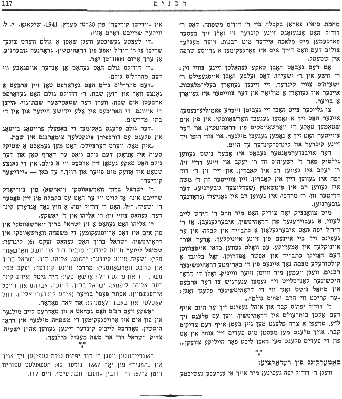
[ Page 117 ]
of R. David that R. David warned his children that it was better to become involved in a trade rather than the rabbinate. It's possible that this was because of the huge fire that took place in town.
His two sons, R. Zusha and R. Yeshayahu heeded his request, as did R. Yeshayahu's two children, who took up trades. One of them became a brick mason, and the other a builder. At the same time they changed their family names. One took the name Warshavsky. His descendants were the Warshavskys of Drohitchin; the other took the name Milner; these names were retained up until the present.
R. Yeshayahu's son, R. Yaakov, and his three sons didn't heed the above request. R. Yaakov was a rabbi in Kobrin, and his own son R. David Yaffe was a rabbinical judge in Kobrin. His second son, R. Moshe, was a rabbi in Pitshatz (Shedlitz gubernia). The third son, R. Mordechai, was rabbi in Goniadz (Grodno gubernia).
Twenty years ago, R. Hirsh Leib Levy, who was born in Drohitchin, stated that R. Davidel Yaffe left a kabbalah manuscript that is in the possession of one of his grandchildren or great-grandchildren in the United States. It's worth finding that manuscript and publishing it. It should exist as a cultural monument to one of the most eminent rabbis in Drohitchin, about whom we know very little. The Drohitchin émigrés should get involved so that no one should repeat the old saying, “He crawls like Rabbi Yaffe's golem.”
R. Davidel Yaffe's grave and structure over the gravesite is still in the old cemetery in Drohitchin. Whenever someone in Drohitchin experienced problems, he would visit the holy man's grave, and light candles for spiritual purposes.
Note from Editorial Board:
There is a similar story about Rabbi Davidel in the Yiddish Courier of March 20, 1941, Chicago. Y.L. Wiecker writes the following:
“The most recent story of the creation of a golem was written to Dr. Davidel Yaffe of Drohitchin, Grodno gubernia in approximately 1800. Rabbi Davidel's golem had a task different from the Maharal's golem. The Maharal's golem had to do his job for six days, and rested on the Sabbath. R. Davidel's golem had to work on the Sabbath, effectively serving as the shabbos-goy, heating the ovens in Jewish homes and the synagogues. The golem would receive his orders on Friday and performed his duties on time on Sabbath morning. Once someone made a minor error and ordered the golem to do something, which he performed automatically. The whole town went up in smoke.” This is the story told in the Yiddish Courier.
Rabbi Yisrael Baruch Warshavsky (Warsaw) of New York wrote us that his family had a tradition from his father, R. Yeshayahu, that R. Davidel had two additional children: R. Eliyahu and R. Yoshka.
R. Eliyahu had a son named Yisrael Baruch Warshavsky, and the Warshavsky family of Drohitchin was his descendants. Yisrael Baruch had six children: Shmuel Leizer (his children were Tuvia-David and Zusha Warshavsky); Yeshayahu (his children were Yehoshua, Eliyahu, David, Yisrael Baruch and Toiba Warshavsky); Mordechai (his children were Yaakov Zvi, Moshe, David and Faiga Rachel Warshavsky); Chaya Gittel (her children were Eliyahu, Lipman, Yisrael Baruch, Leizer, Avraham and Reichel Eisenstein); Esther Pessel Buder (her children were Eliyahu, Rachel Kotler and Baba Zlotnick); and Leah Fodor.
Yoshka had a son Todres Leib Milner, who was the ancestor of Milner family in Drohitchin. Todres Leib's children were Aharon Yeshayahu, Zadok, Yisrael David and Moshe Mendel Milner.
The description of R. David Yaffe's golem is also in Hamagid from 1867, number 42; Heschel's stories, pp. 2-57; Dr. Rubin, Acts of Deception, p. 117.
[ Page 117 ]
JewishGen, Inc. makes no representations regarding the accuracy of
the translation. The reader may wish to refer to the original material
for verification.
JewishGen is not responsible for inaccuracies or omissions in the original work and cannot rewrite or edit the text to correct inaccuracies and/or omissions.
Our mission is to produce a translation of the original work and we cannot verify the accuracy of statements or alter facts cited.
 Drogichin, Belarus
Drogichin, Belarus
 Yizkor Book Project
Yizkor Book Project
 JewishGen Home Page
JewishGen Home Page
Copyright © 1999-2025 by JewishGen, Inc.
Updated 9 Feb 2015 by LA